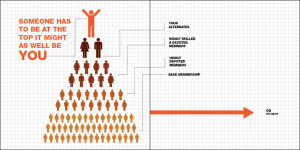I first learned about Jonestown – however briefly – in a sociology class roughly a decade ago. It was beyond my comprehension how such an event could occur on such a large scale. The lack of understanding of the situation makes it easy to dismiss the people of Jonestown as insane and brainwashed. It is difficult to empathize with a group of people seemingly so strange and different from the rest of American society. It is easy to dehumanize them based on the perceived differences. We comfort ourselves with the belief that such a thing could never happen to us, our family, our friends and our acquaintances. All of these separations result in a grave disservice, not only to the people of Jonestown, but also to ourselves. Our lack of understanding translates into a lack of knowledge of our own spirit, our own needs and wants.
In my graphic design graduate work, I have been researching authority figures, people we admire growing up, people we respect and celebrate for their accomplishments, their strength and their genius.
 Jim Jones fit that role for many. He stood up for the right of many, he inspired social change, and he gave hope for a better future. That was a side so many people saw, and in fact often that was the only side they saw.
Jim Jones fit that role for many. He stood up for the right of many, he inspired social change, and he gave hope for a better future. That was a side so many people saw, and in fact often that was the only side they saw.
But there was another side, a side that resulted in the tragedy of November 1978. Jones’ control of information and his interpretation of events was near complete in Jonestown. His reports of race riots, police brutality and concentration camps in the United States frightened Jonestown residents. Malnourished, sleep-deprived, overworked and physically strained, functioning on misinformation, living in fear of invasion from armed mercenaries, it all combined to overwhelm logic and critical thinking.
My research into Peoples Temple took me to the Jonestown Institute site and the many primary source documents, photographs and audiotapes which helped to paint a clearer picture of the Peoples Temple and its members. Through this research, I became acquainted with the members of the Peoples Temple on a very basic level. I could see their smiling faces, hear the joy and camaraderie in their voices, read their letters and prayers, and witness their laughter, their fear and angst… all this with the knowledge of what was to come.
And this was my dilemma: I wanted to show the humanity of these individuals, and capture the viewer’s interest without focusing in the stigma created by the shockingly gruesome end that these people met.
In his book Mythologies, French philosopher Roland Barthes wrote, “To see someone who does not see is the best way to be intensely aware of what he does not see.” My project emerged in the form of a guide on how to become a cult leader. The obscure topic of the book proves both intriguing and shocking. The term “cult” preys on the preconceived notions of mind-control and brainwashing of the weak-minded. The misconception of weak-mindedness on the part of the Peoples Temple members had little to do with the reality and more so with circumstances that the members faced in their lives.
The guide breaks the process into fourteen sections, growing darker with each topic covered. The text of the guide is supported by simple icons and revealing photographs of Jim Jones, Peoples Temple members, and Jonestown.
The viewer of my work should be able to find parallels to their own life, and see how vulnerable we can be, or at one time have been, to the influences of others. The residents of Jonestown were regular people, with the same hopes and dreams that so many of us have. My hope and intention is for the viewer of my work to come away understanding the importance of utilizing critical thinking skills in their own lives, to see the humanity in those we perceive as different from us and our culture, and to remember the past.
(Lyubov Klimova is a graduate student in graphic design at San Diego State University).